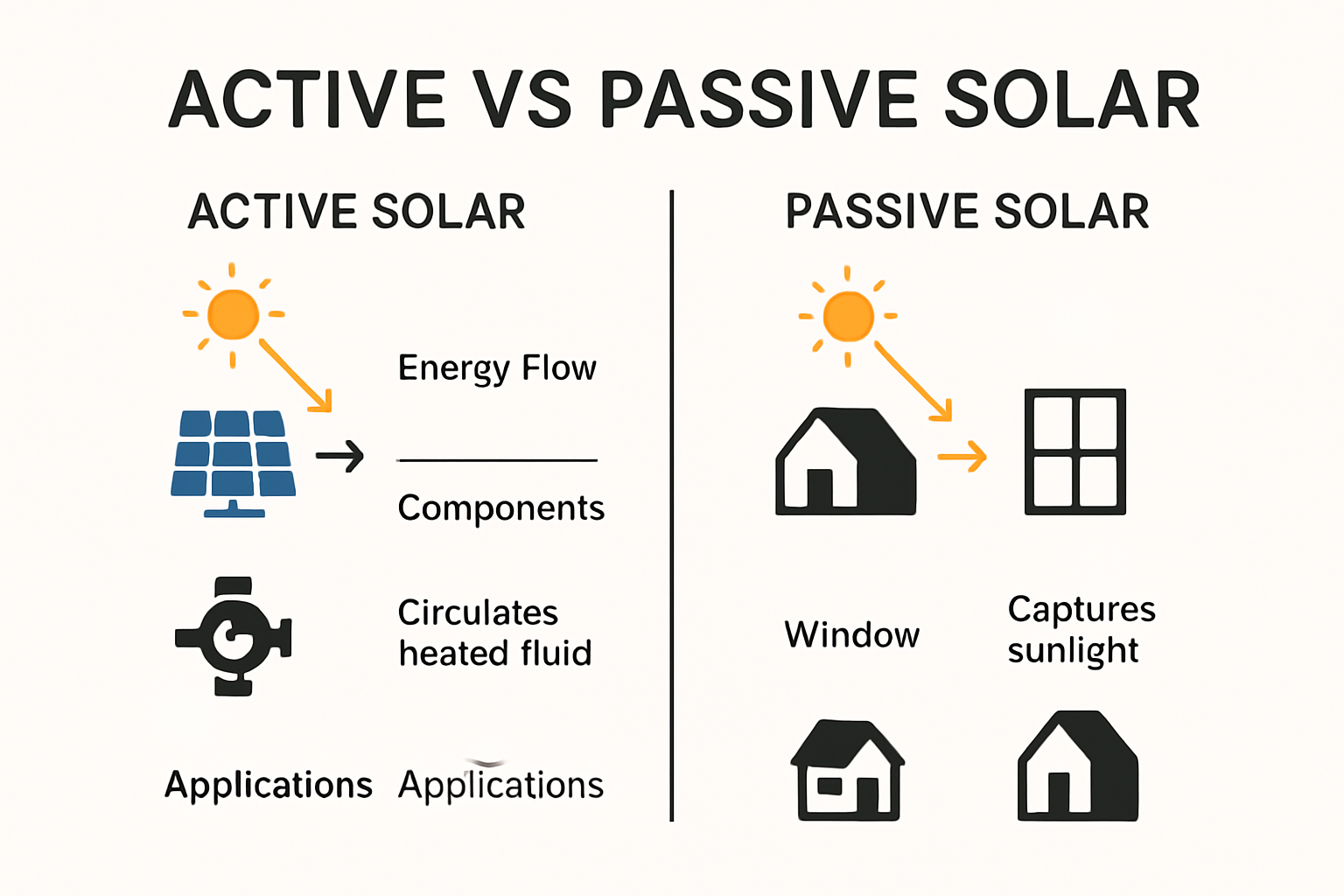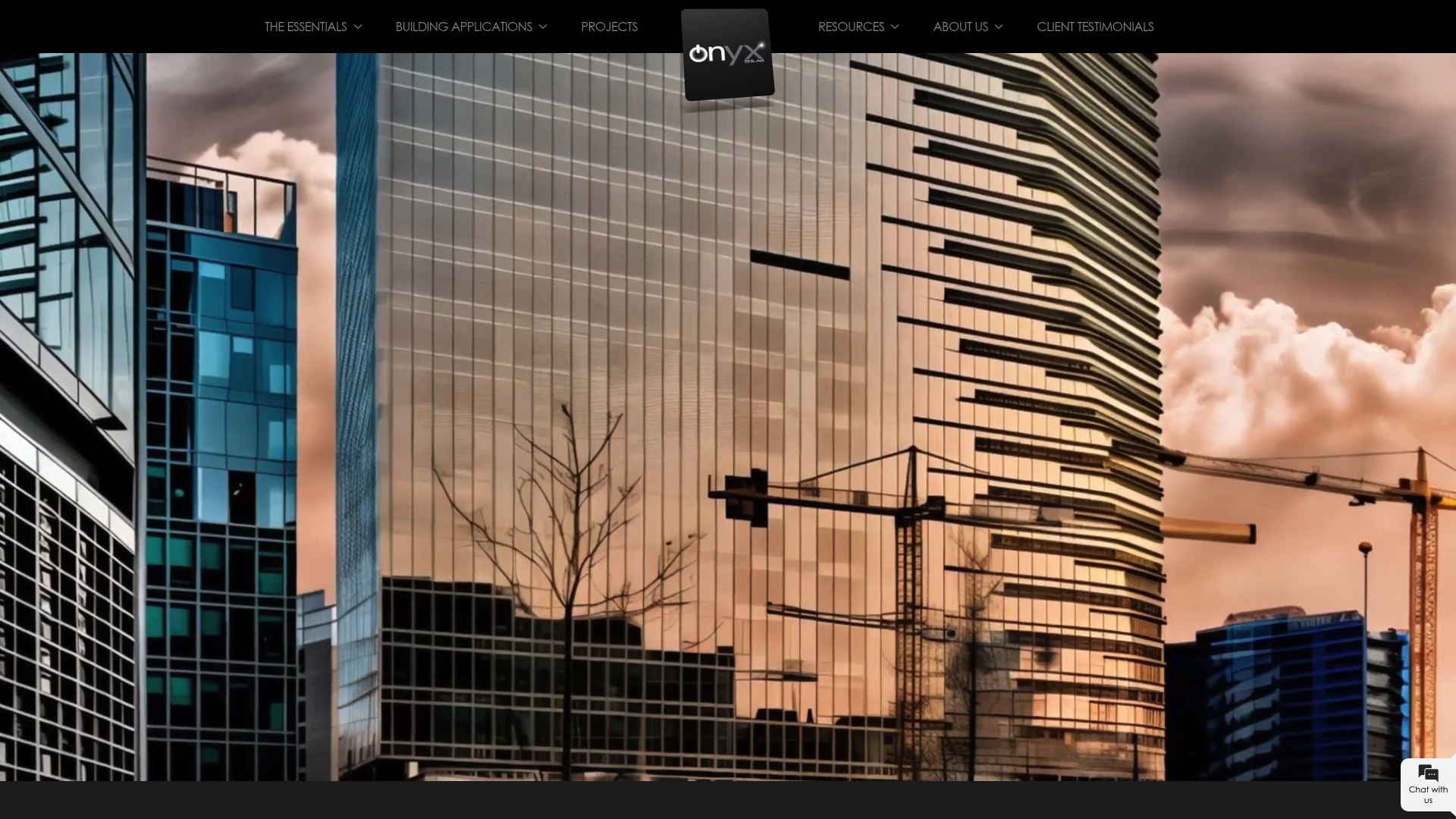
July 16, 2025
Onyx Solar USA
79 Madison Avenue, Ste. #231
New York, NY 10016
usa@onyxsolar.com
+1 917 261 4783
Onyx Solar Spain
Calle Río Cea 1, 46,
05004 Ávila. Spain.
info@onyxsolar.com
+34 920 21 00 50

Solar technology has changed the way architects and developers approach building design, with bold claims about energy savings on every project brief. Yet, the real kicker is not just the promise of green energy but the whopping differences between solar system types. For example, active components can boost solar productivity by up to 277.5 percent compared to passive setups. Instead of simply choosing one or the other, cutting-edge projects often combine both methods for results that go far beyond traditional efficiency benchmarks.
| Takeaway | Explanation |
|---|---|
| Active vs. Passive Characteristics | Active solar systems utilize mechanical components for energy management, leading to higher energy output, while passive systems rely on design and materials for energy efficiency without mechanical aid. |
| Site-Specific Design Importance | Successful solar implementation depends on factors like building orientation and local climate, necessitating custom solutions tailored to each project’s unique context. |
| Integration of Strategies | A hybrid approach combining active and passive design principles can maximize energy efficiency, allowing buildings to function as energy-generating ecosystems. |
| Thermal Mass Utilization | Selecting materials like concrete or brick for thermal mass can enhance energy efficiency by regulating indoor temperatures through natural heat absorption and release. |
| Effective Shading Solutions | Advanced shading strategies are crucial for controlling solar heat gain and improving energy performance, underscoring the need for smart design responsive to environmental conditions. |
Solar energy systems represent a critical pathway for sustainable architectural design, with active and passive solar technologies offering distinct approaches to harnessing renewable energy. Architects and developers must understand the fundamental differences between these systems to optimize building performance and energy efficiency.
Active solar systems utilize mechanical and electrical components to convert and transfer solar energy. These systems typically include photovoltaic panels, pumps, and complex equipment that actively collect, store, and distribute solar energy throughout a building. Mechanical intervention is the key distinguishing factor, allowing for more precise energy management and higher potential energy output.
In contrast, passive solar systems rely on building design, materials, and natural principles to capture, store, and distribute solar energy without additional mechanical equipment. According to a systematic review, passive design strategies can reduce indoor temperatures by an average of 2.2°C and decrease cooling loads by 31%, demonstrating significant potential for energy optimization.

The performance of solar systems varies dramatically based on design and environmental conditions. Research in Kirkuk, Iraq demonstrated that integrating active components into solar systems could increase productivity by up to 277.5%, with thermal efficiency reaching 36% during peak months.
Active solar technologies excel in scenarios requiring precise energy control and higher energy generation. These systems can incorporate advanced tracking mechanisms that adjust solar panel orientation to maximize sunlight capture throughout the day. Photovoltaic installations with active cooling mechanisms can further enhance performance. As research indicates, passive cooling strategies can lower solar panel temperatures by up to 15°C, directly improving power generation efficiency.

Selecting between active and passive solar systems requires careful consideration of multiple factors including building typology, geographic location, energy requirements, and budget constraints. Passive systems offer lower installation and maintenance costs, making them attractive for projects prioritizing sustainable design with minimal mechanical intervention.
Active solar systems provide greater flexibility and potential for energy generation, making them ideal for complex architectural projects with significant energy demands. Architects must evaluate the long term performance metrics, considering not just initial installation costs but also potential energy savings, maintenance requirements, and environmental impact.
Ultimately, the most effective solar strategy often involves a hybrid approach that strategically combines active and passive solar design principles, creating comprehensive solutions tailored to specific architectural and environmental contexts.
Here is a table summarizing the key differences between active and passive solar systems as described above.
| Feature | Active Solar Systems | Passive Solar Systems |
|---|---|---|
| Main Mechanism | Mechanical & electrical components (e.g., PV, pumps) | Design, materials, and natural principles |
| Energy Management | Precise, controllable | Relies on inherent building design |
| Installation & Maintenance | Higher cost, more complex | Lower cost, simpler |
| Flexibility | High, can adjust to demand | Limited by design decisions |
| Efficiency Potential | Can boost productivity by up to 277.5% | Can reduce cooling loads by 31%, cut temps by 2.2°C |
| Suitability | Complex/high-demand buildings | Simple/low-demand or sustainability-priority projects |
Selecting an appropriate solar strategy requires a nuanced understanding of project-specific requirements, architectural constraints, and energy performance goals. Architects and developers must conduct a comprehensive evaluation that goes beyond simple energy generation metrics.
The success of solar implementation depends critically on site-specific factors. Sustainability experts at Williams College emphasize that proper building orientation, strategic shading, and intelligent thermal mass integration can dramatically reduce energy consumption. Architectural context becomes the primary determinant in solar strategy selection.
Building typology plays a crucial role. Commercial office buildings with significant electrical loads might benefit from active solar systems, while residential structures could optimize performance through passive design principles. The National Renewable Energy Laboratory recommends analyzing solar exposure, local climate patterns, and existing architectural elements before finalizing a solar approach.
Economic considerations extend beyond initial installation costs. Active solar systems typically require higher upfront investments but offer more precise energy management. Pennsylvania State University research highlights that mechanical solar technologies can provide more consistent energy output across variable environmental conditions.
Passive solar strategies, conversely, offer lower implementation costs and reduced maintenance expenses. Architects can learn more about generating energy without compromising architectural space, which becomes increasingly important in urban environments with limited development areas.
The most sophisticated solar strategies emerge from an integrated design philosophy that combines active and passive technologies. This holistic approach allows architects to maximize energy efficiency while maintaining aesthetic integrity. Thermal performance, natural lighting, and renewable energy generation become interconnected design objectives.
Successful implementation requires collaboration between architects, energy consultants, and mechanical engineers. Each project demands a custom solution that balances technological capabilities, budgetary constraints, and sustainability goals. By treating solar strategies as dynamic design elements rather than mere technical additions, developers can create buildings that generate energy while enhancing architectural expression.
Ultimately, the right solar strategy transforms buildings from energy consumers into active participants in sustainable urban ecosystems.
Comparing active and passive solar systems requires a comprehensive analysis of economic, performance, and environmental factors. Architects and developers must evaluate these technologies beyond simplistic metrics, considering long-term implications for building design and sustainability.
The financial landscape of solar technologies reveals nuanced cost dynamics. Research analyzing public building configurations demonstrated that active solar water heaters can provide substantially higher energy bill savings compared to passive energy efficiency actions. Economic performance varies dramatically based on system complexity and implementation strategy.
Initial investment costs differ significantly between active and passive systems. Active solar technologies typically require higher upfront expenses due to mechanical components and sophisticated equipment. A detailed school building analysis illustrated that integrating active strategies like advanced lighting controls could reduce annual energy consumption to 21.82 kWh/m², achieving an impressive 51.36% energy saving rate.
Performance comparisons reveal compelling advantages for both system types. Scientific research comparing solar still technologies found that active systems produced 5.5 L/m² of water, outperforming passive systems which generated 3.9 L/m². Moreover, the active system demonstrated a remarkable 41% reduction in CO₂ emissions and a lower cost per liter of production.
Efficiency is not solely about energy generation but also about comprehensive environmental impact. Active systems offer precise energy management through mechanical interventions, while passive systems leverage architectural design to optimize natural energy flows. The most effective approach often involves strategic hybridization that maximizes each technology’s strengths.
Sustainability considerations extend beyond immediate energy generation. Passive solar design inherently reduces mechanical complexity, potentially lowering embodied carbon in construction materials. Active solar technologies, while more mechanically intricate, can provide more consistent and controllable renewable energy output.
Architects must consider lifecycle assessments that evaluate carbon footprint, maintenance requirements, and long-term performance degradation. Explore strategies for generating energy without compromising architectural space, which becomes increasingly critical in urban environments with limited development areas.
The optimal solar strategy emerges from a holistic understanding that balances economic feasibility, performance requirements, and environmental responsibility. By treating solar technologies as integrated design elements rather than standalone systems, developers can create buildings that are not just energy-efficient but regenerative ecosystems.
The following table summarizes key performance and sustainability metrics comparing active and passive solar systems based on data presented in this section.
| Metric | Active Systems | Passive Systems |
|---|---|---|
| Energy Output (Water Production, L/m²) | 5.5 | 3.9 |
| CO₂ Emission Reduction | 41% reduction | — |
| Efficiency Boost/Temperature Impact | Up to 277.5% productivity increase | 2.2°C lower indoor temps, 31% less cooling |
| Cost per Output Unit | Lower (per L of water produced) | Higher (per L of water produced) |
| Installation & Maintenance Cost | Higher | Lower |
| Annual Energy Savings Rate | Up to 51.36% (with active strategies) | — |
Optimizing solar efficiency requires a strategic approach that integrates architectural design, material selection, and technological innovation. Architects and developers must adopt a holistic perspective that goes beyond traditional energy generation methodologies.
Skyrie Design research emphasizes the critical importance of building orientation. Aligning the building’s longest axis along the east-west direction maximizes solar exposure, with south-facing windows capturing maximum winter sunlight while minimizing unwanted heat gain from eastern and western exposures. Architectural geometry becomes a fundamental mechanism for energy performance.
Strategic window placement and sizing directly impact solar efficiency. Large, carefully positioned windows create natural thermal regulation, allowing sunlight penetration during winter months and enabling passive heat management. Explore innovative solar façade applications that transform building envelopes into energy-generating surfaces, demonstrating how architectural elements can simultaneously serve aesthetic and functional purposes.
Sustainability experts at Williams College highlight thermal mass as a crucial design strategy. Materials like concrete, brick, and stone possess exceptional heat absorption and storage capabilities. By strategically placing these materials in areas receiving direct sunlight, architects can create natural temperature regulation systems.
Thermal mass materials act as energy reservoirs, absorbing solar heat during daylight hours and gradually releasing it during cooler periods. This passive heat management approach reduces mechanical cooling and heating requirements, creating more energy-efficient building environments. The selection of appropriate materials becomes a sophisticated design intervention that extends beyond traditional architectural considerations.
Effective shading represents a nuanced approach to solar efficiency. Sustainability research demonstrates that well-designed overhangs, architectural screens, and vegetation can prevent excessive summer heat gain while preserving winter solar access. These shading strategies must be precisely calculated based on local solar trajectories and seasonal variations.
Modern architectural solutions integrate dynamic shading systems that adapt to changing solar conditions. Movable architectural elements, smart glass technologies, and algorithmically designed solar screens provide unprecedented control over solar heat gain. By treating shading as an active design parameter, architects can create buildings that respond intelligently to environmental dynamics.
Maximizing solar efficiency demands a comprehensive understanding of architectural physics, material science, and environmental interaction. The most successful designs emerge from an integrated approach that views solar technologies not as add-on systems but as fundamental design generators transforming buildings into responsive, energy-generating organisms.
Active solar systems utilize mechanical and electrical components such as photovoltaic panels and pumps to convert solar energy into usable energy. They allow for precise energy management and can increase energy output significantly compared to passive systems.
Passive solar systems rely on building design, materials, and natural principles to capture and distribute solar energy without the use of mechanical systems. They depend on architectural features such as windows, walls, and thermal mass to maintain comfortable indoor temperatures.
Choosing between active and passive solar systems involves considering factors such as building typology, geographic location, energy requirements, and budget. Often, a hybrid approach that integrates both systems can maximize energy efficiency and performance
Combining active and passive solar strategies allows buildings to become energy-generating ecosystems. This integrated approach maximizes energy efficiency, reduces reliance on mechanical systems, and can lead to enhanced architectural aesthetics.
Architects and developers face real challenges when trying to balance energy output, design flexibility, and cost-efficiency, especially when choosing between active and passive solar solutions. The article highlights that combining these strategies delivers the highest energy savings, yet many professionals struggle to find products that seamlessly integrate both, while also meeting high design standards and sustainability goals.

Let Onyx Solar help you overcome these barriers. Our Building Integrated Photovoltaic glass products unite active and passive solar concepts, delivering measurable energy savings and enabling your next project to exceed net-zero, energy-positive, and carbon reduction targets. With a global portfolio of over 500 projects, our solutions empower you to create buildings that are not just efficient but truly future-proof. Learn more about how our BIPV technology can be tailored to your project’s needs by visiting Onyx Solar’s main site. Start your journey to smarter solar architecture today.
Over 500 projects completed across 60 countries on all five continents.
Learn how our photovoltaic solutions are shaping the future of architecture.
Explore our full catalogue available in PDF or as an AUDIOBOOK.